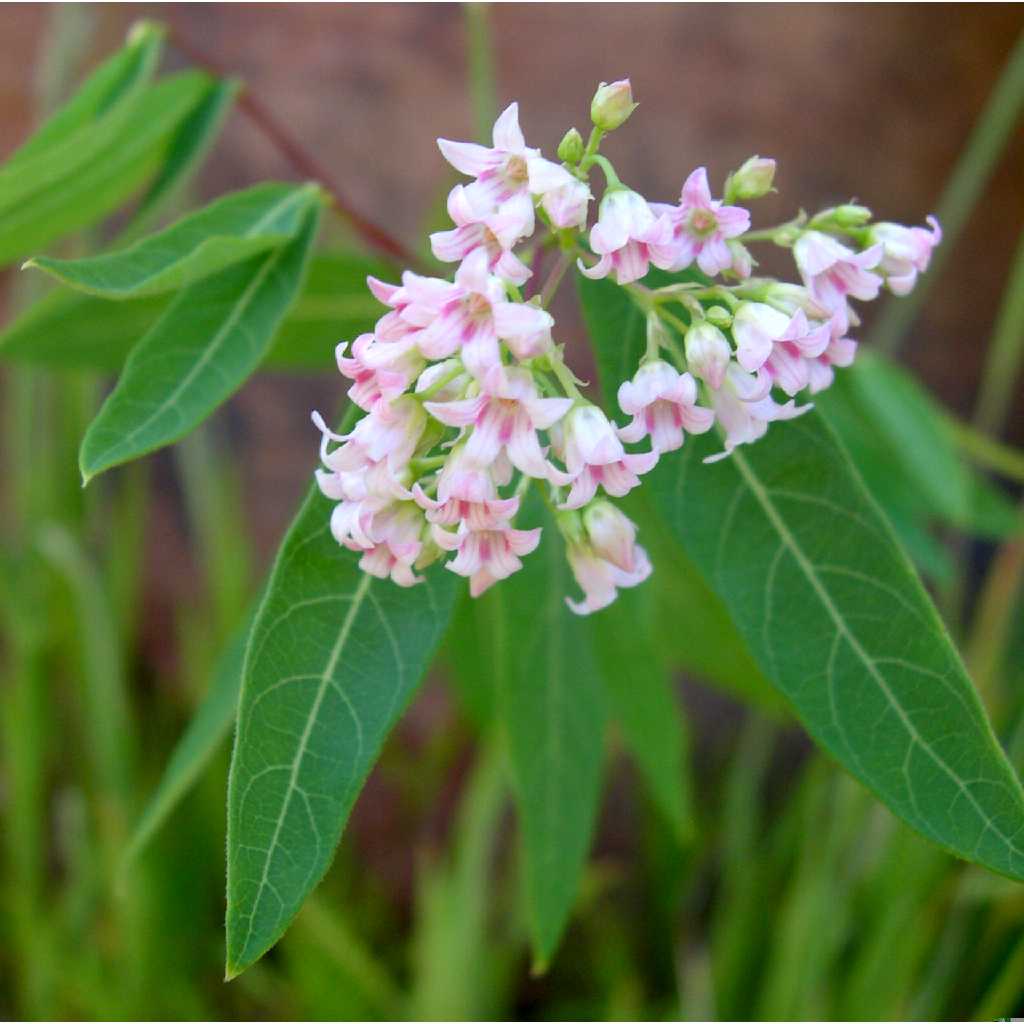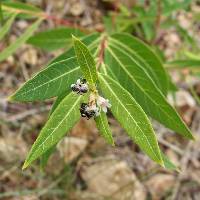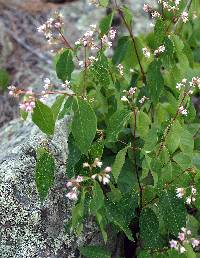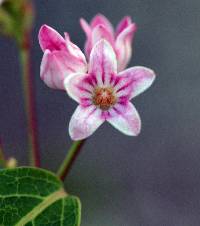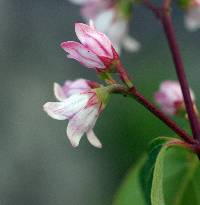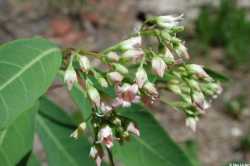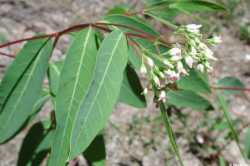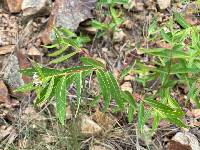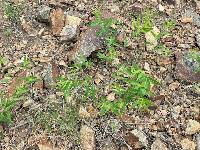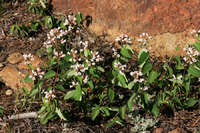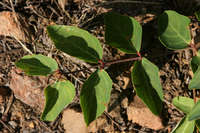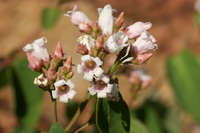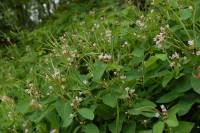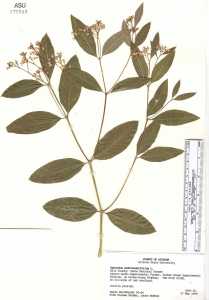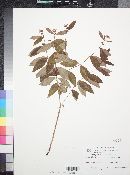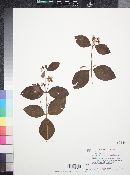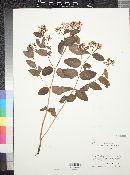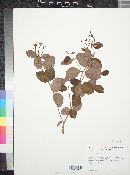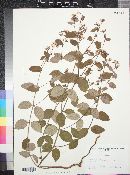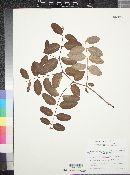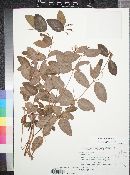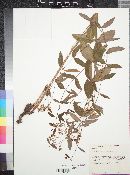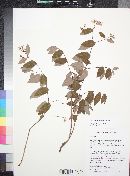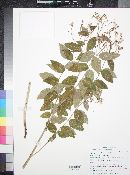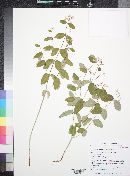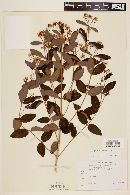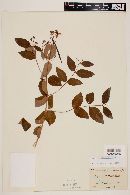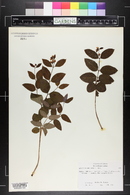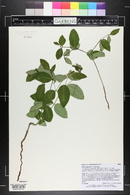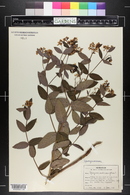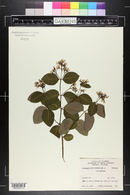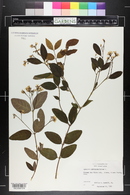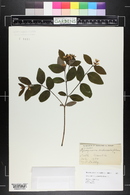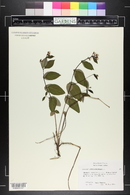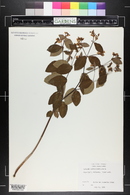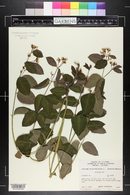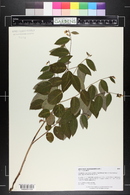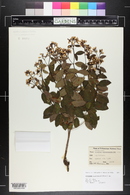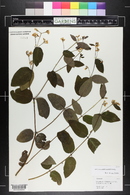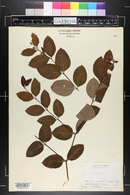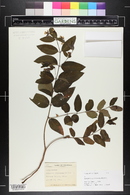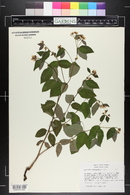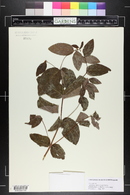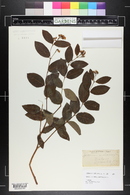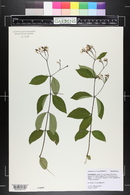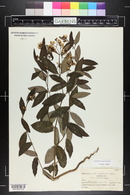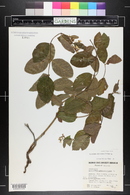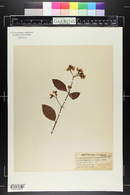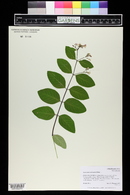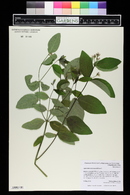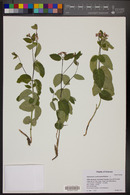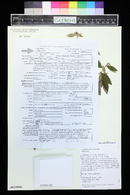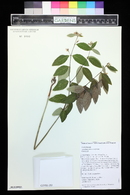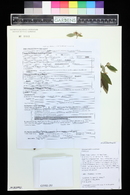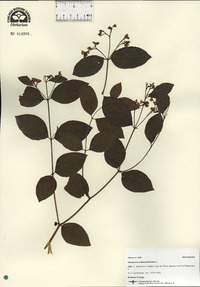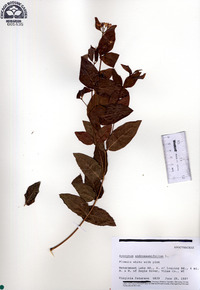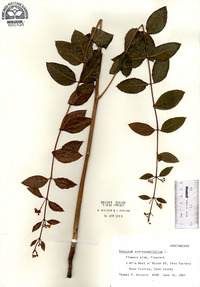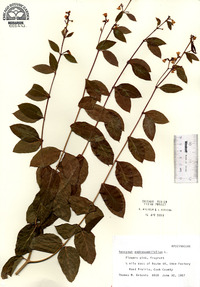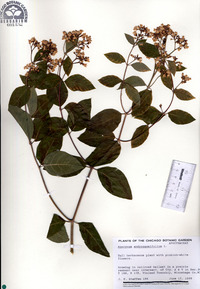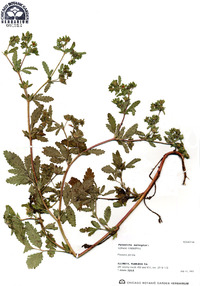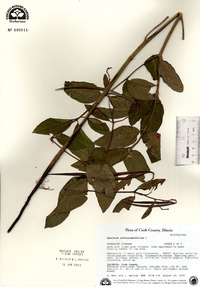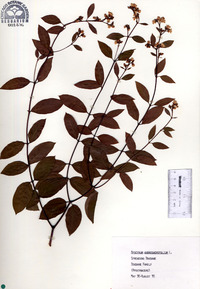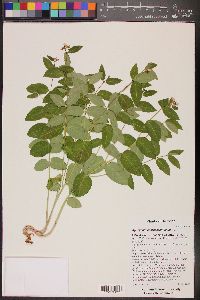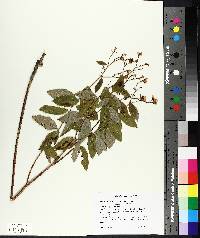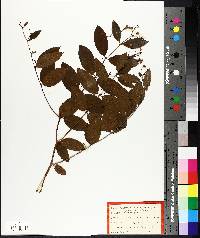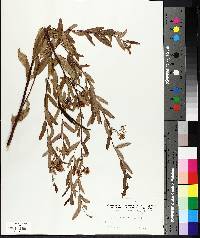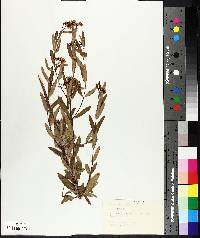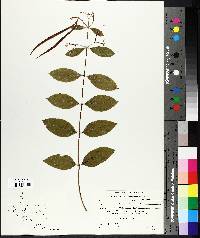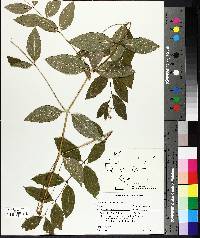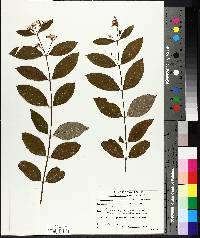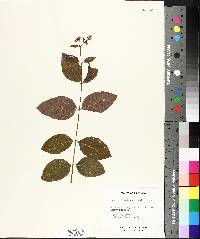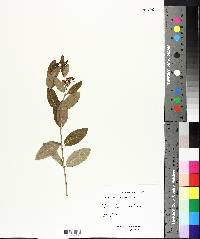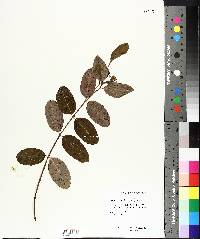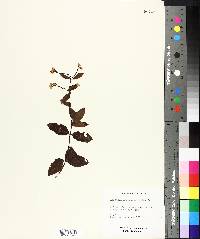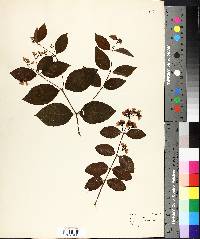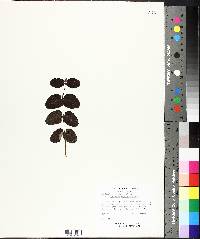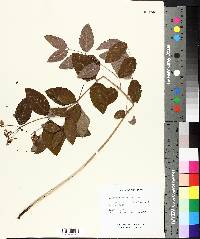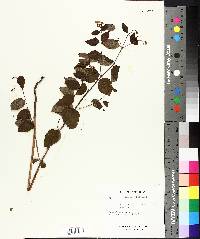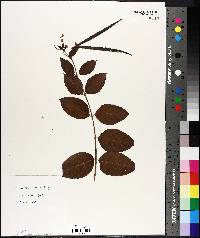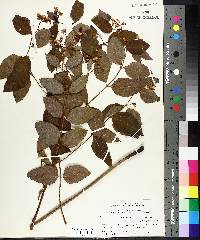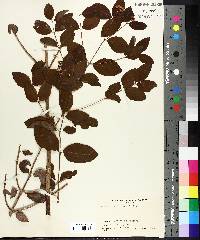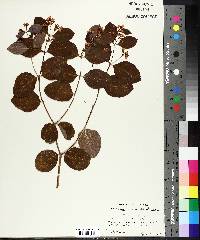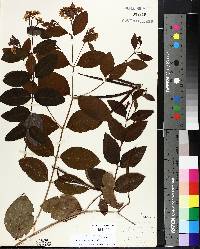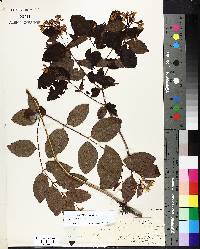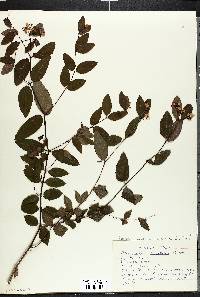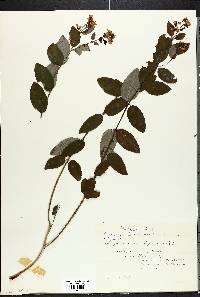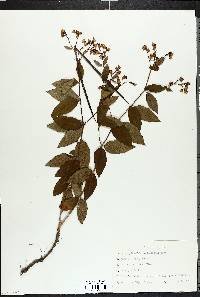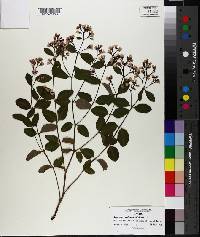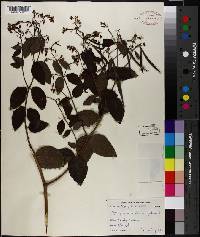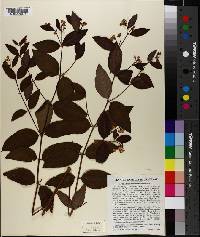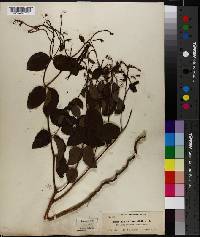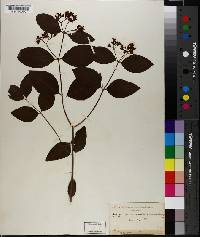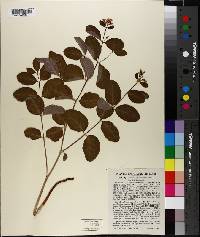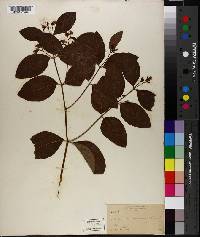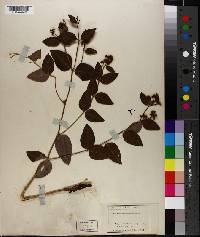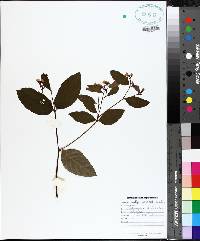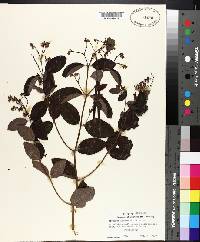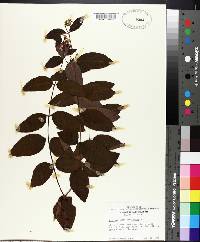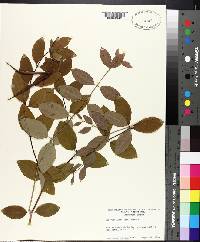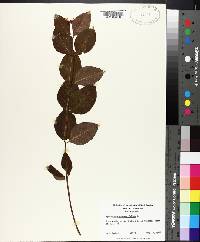
|
|
|
|
Family: Apocynaceae
Spreading Dogbane
[Apocynum ambigens Greene, moreApocynum androsaemifolium var. glabrum Macoun, Apocynum androsaemifolium var. griseum (Greene) Bég. & Bel., Apocynum androsaemifolium var. incanum A. DC., Apocynum androsaemifolium var. intermedium Woods., Apocynum androsaemifolium var. pumilum A. Gray, Apocynum androsaemifolium var. tomentellum (Greene) Boivin, Apocynum androsaemifolium var. woodsonii Boivin, Apocynum macranthum , Apocynum pumilum (A. Gray) Greene, Apocynum pumilum var. pumilum , Apocynum pumilum var. rhomboideum (Greene) Bég. & Bel., Apocynum scopulorum Greene ex Rydb.] |
Perennial herb 10 - 80 cm tall Leaves: opposite, many drooping or reflexed, on slender stalks with glands in or above the axils. The blades are dark green (but paler on underside), 3 - 8 cm long, egg-shaped to broadly elliptic, with an abruptly pointed spine-tip, non-toothed edges, and usually some hair on the underside, though hairless above. Inflorescence: of individually stalked, declined, nodding, or spreading flowers in terminal, fairly elongate, branched clusters, and also smaller clusters in the upper leaf axils. The inflorescence clusters often surpass the leaves and lateral branches in height. Flowers: pinkish with red marks inside, 0.6 - 1 cm long, 0.5 - 1 cm wide, radially symmetric, bell-shaped, and quite fragrant. Sepals: five, but fused at base, then separating into triangular, pointed lobes, which are less than, or only up to half the length of the petal tube. Petals: five, but fused for most of their length, then separating into very short, spreading or recurved lobes, with the petals overall about three times longer than the sepals. Inside, near the base of the petal tube, and opposite each lobe, is a tooth or scale. Stamens: five, with separate, short filaments attached to the inside of the petal tube, but the lance-triangular-shaped anthers fused together, surrounding and connected to the stigma, and prolonged beyond the stigma into a cone. Pistil: with two, superior ovaries, which are subtended by five nectaries, but the two ovaries sharing a single style and stigma. Fruit: of two, dry, single-chambered, many-seeded, 5 - 20 cm long, elongate, slender, spindle-shaped (with gradually narrowed ends), capsule-like pods (follicles), which open lengthwise by a single seam. Stems: ascending-spreading or loosely ascending, unbranched or branched, but then without a central axis. The stems are tough, fibrous, and exude a milky, acrid juice or latex sap when cut or broken. Seeds: numerous, 2.5 - 3 mm long, narrowly elliptic to sickle-shaped, with a conspicuous tuft of 1 - 2 cm long hairs (coma) at one end. Similar species: Apocynum androsaemifolium is quite similar to A. cannabinum and A. sibiricum except the flowers of those species are erect, greenish white, normally not over 0.5 cm long, with more erect petal lobes; the leaves typically do not droop; the inflorescence is broader, not elongate, and usually surpassed in height by sterile lateral branches; the hairs of the seeds are often over 2 cm long; and the seeds are at least 4 mm long. Apocynum x floribundum, the hybrid between these two similar species and A. androsaemifolium, is also very similar since it has pale pinkish flowers, but its flowers are smaller (usually under 4.5 mm long, and only up to 6 mm wide), the petal lobes do not recurve, the flowers typically do not droop, the inflorescences are mostly terminal, and more of the stem leaves spread or even ascend. Flowering: late May to early September Habitat and ecology: Fairly common in several habitats, but usually in open oak woods or other upland, open woody areas such as black oak savannas. This species does well after disturbance, and fire may play an important part in its occurrence, since it typically prefers open environments rather than dense, closed communities. Occurence in the Chicago region: native Notes: Hybridization is very common between this species and both A. cannabinum and A. sibiricum. The flowers of our Apocynum species are very fragrant and attract many insects. According to Voss (1996), a particularly striking leaf-beetle, Chrysochus auratus Fabr. is often seen associating with species of Apocynum, and its larvae feed on the roots, thus it has been known commonly as the "dogbane beetle". Several species in the Apocynaceae family are used as sources of chemicals in medicine, or in poisons, and most members of the family are poisonous due to the presence of the milky latex sap. Native Americans were known to use the tough, fibrous stems of Apocynum for material fibers (Voss 1996). Author: The Field Museum Jepson 1993, McLaughlin 1993, Martin and Hutchins 1980 Duration: Perennial Nativity: Native Lifeform: Forb/Herb General: Erect diffuse branched stems with a milky latex, emerging from horizontal rootstocks, the stems glabrous. Leaves: Opposite, glabrous to sparsely hairy above, sparsely to densely hairy below, ovate to oblong lanceolate, 2-6 cm long and 1.5-3.5 cm wide, with petiole 1-5 mm long, those along stem broader and drooping. Flowers: Terminal or axillary cyme, the calyx with ovate to lanceolate lobes, these 1-3 mm, the corolla bell or urn shaped, white, with occasional pink or red veins, corolla 4-8 mm long, lobes spreading to reflexed. Fruits: Narrow, terete follicle, pendent to erect, 6-15 cm long. Ecology: Found in open to rocky sites, often in higher elevation forests from 5,000-10,000 ft (1524-3048 m), flowers May-September. Distribution: Widespread north to Canada, across the Pacific west and northwest, east to Georgia and eastern North America. Notes: Note the conspicuous difference in color on leaves, from dark green above to whitish, hairy below. Ethnobotany: Used to bathe dogs with mange, taken for headaches, used for convulsions, colds, ear infections and soreness, and used for nosebleeds. Etymology: Apocynum is from Greek apo, away from, and kyon dog, hence dogbane, while androsaemifolium means having leaves like the genus Androsaemum. Synonyms: Apocynum ambigens, A. androsaemifolium var. glabrum, A. ancrosaemifolium var. griseum, A. androsaemifolium var. incaum, A. androsaemifolium var. intermedium, A. androsaemifolium subsp. pumilum, A. androsaemifolium var. pumlium, A. androsaemifoium var. tom Editor: SBuckley, 2011 Stems 2-8 dm, often ±inclined from the vertical, either simple or branched and then lacking a central axis; lvs petiolate, drooping, oblong-lanceolate to ovate, 3-8 cm, usually hairy beneath; principal cymes terminal; secondary smaller cymes in the upper axils; fls declined or nodding; cal-lobes triangular, to half as long as the cor-tube; cor campanulate, 6-10 mm, pinkish, marked with red inside, the lobes spreading or recurved; fr 5-15 cm; coma 1-2 cm; 2n=16. Upland woods, occasionally in fields and roadsides; Nf. to B.C., s. to Ga., Tex., and Ariz. May-Aug. Gleason, Henry A. & Cronquist, Arthur J. 1991. Manual of vascular plants of northeastern United States and adjacent Canada. lxxv + 910 pp. ©The New York Botanical Garden. All rights reserved. Used by permission. From Flora of Indiana (1940) by Charles C. Deam More or less infrequent in rather sandy or gravelly soil throughout the northern counties along roadsides and in open woodland, where it is associated with black and white oak. In southern Indiana it has a similar habitat but becomes rare to very rare. ...... Indiana Coefficient of Conservatism: C = 6 Wetland Indicator Status: UPL Diagnostic Traits: Erect perennial; leaves opposite; flowers in cymes; corolla bell-shaped, pinkish, 5 mm or more. |
|
|
|

